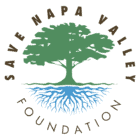From the Save Napa Valley Foundation:
We at the Save Napa Valley Foundation (SNVF) write to share our firm belief that the recent changes in policy and in the political climate in Napa County is not only long overdue, but is beneficial for our residents, for the health of our natural environment, and for the future of our wine industry. Which is, after all, the industry whose health and success drives the economic viability of Napa County.
We offer here some shared realities. Current policies regarding water extraction and protection of our watershed lands are outdated and have led to deficiencies in our groundwater. The Napa River is impaired and is running dry in increasing frequency and duration, and our watersheds (the surrounding hillsides) are the target for numerous home and/or vineyard projects that would require deforestation. The valley floor is all but planted out, and developers now reach into the hillsides where the rain water begins its journey to the river, streams and reservoirs. As in many counties in California and in our country, our county government has not done enough to ensure a secure water future for us all. Thankfully, this is beginning to change.
Back in 1968, when the Ag Preserve was established, the brilliant futurists that devised it had no concept that our hillsides would ever be used considered economically viable for wine grape production.
SNVF was founded in 2016 by a group of dedicated wine growers and vintners who were concerned about the long-term success of the wine industry. Water is life, and its continued health and abundance is essential. We supported Measure C in 2018, which focused on maintaining and protecting our forested hillsides. Since then, we have been working with other NGO’s and environmental groups to establish science-based policies that help protect our water supplies, water being our scarcest shared resource.
Now we are seeing victories for our beautiful forests that surround the valley floor. Recently, we witnessed and appreciated the first few victories for our forested wildlands when those at Mountain Peak on Soda Canyon Road and Le Colline in Angwin were preserved. In both cases, the Napa County Board of Supervisors made the decision to disallow hillsides to be deforested and converted to vineyards. In the case of Le Colline, supervisors cited numerous conservation regulations in their decision to turn down the project, many pertaining to water quality and quantity inherent in this project. Le Colline is adjacent to Conn Creek, the primary surface water supply to Hennessey Reservoir. The property location is also adjacent to Linda Falls Preserve. These were but two of the project’s significant environmental downsides.
New supervisors Joelle Gallagher and Anne Cottrell, as well as Belia Ramos and Ryan Gregory, can see that policy changes are needed for environmental health and the sustainability of the wine industry, which truly go hand in hand. With this turning tide, SNVF is feeling optimistic for the first time in many years. With Anne’s, Joelle’s and Belia’s votes, a vineyard slated in the wrong place at the wrong time was denied and forest, wildlife, habitat, and essential water was protected. This new board is using science and facts as they diligently, in an unbiased manner, work for all of us: community members, winery owners and growers.
Thus, SNVF is writing to express how refreshing it is to see that discretion has been put back into discretionary decisions.
While these two victories give us hope, at this time there are 31 pending erosion control plans, and the county has been unable to provide the number of plans already approved. Pervasive leniency from the county over the last 20 years has resulted in overdevelopment and poor management of our water resources. The county staff has produced flawed documentation leading to poor decision making. And worst of all, numerous inappropriate developments have been approved based on a purposeful misinterpretation of the 2008 General Plan’s statement, “…. agriculture is the highest and best use of land in Napa.” That statement was never meant to apply to the deforestation of our watershed.
Now more than ever, the urgency of Climate Change requires a paradigm shift towards managing our water, preserving our carbon-sequestering and cooling forests, protecting the essential terroir viability of our existing vineyards, and conserving the rare biodiverse hot spot that is Napa Valley!
We have the science to do this! Save Napa Valley Foundation, with Water Audit California, a public benefit group, has put together an expert team of hydrologists from academia, esteemed scientists in the field of watershed study, environmental attorneys, fish experts and biologists. While these respected scientists have attempted to provide the county with their resources and findings, to date they have not found a particularly receptive audience.
Our County Leaders are responsible for the public trust. The water that flows in the streams, river and tributaries, as well as the groundwater, are all connected and all part of that responsibility. The better we measure our resources, the better we can manage them. By joining community members, city and county leaders, environmental groups, farmers, industry leaders, and esteemed scientists, we can create a healthier Napa County and assure that the wine industry, along with all of us who choose to call this home, prosper.
To reiterate, the climate crisis demands immediate action. It is our Board of Supervisors who can drive Napa County in the right direction. Which leads to what is deeply important at this moment in time – there are two open positions to be filled on the BOS next year. The primary vote comes in March. Let’s keep the ball rolling. Please join SNVF and help us elect supervisors who are not afraid to stand up, who see the need for balance between nature and development and who will take action to protect our most valuable and scarce resources, among them our open space, forest land, and our water. Which will, after all, protect the viability of winegrowing in Napa County far into the future.

